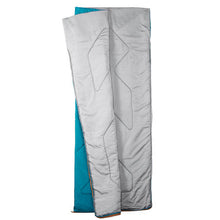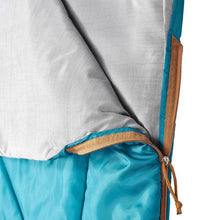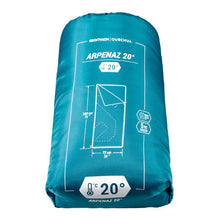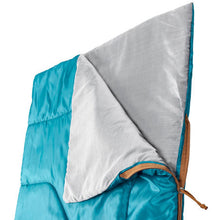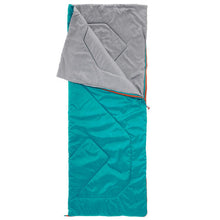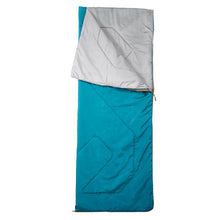
This Arpenaz 20° sleeping bag is designed so you can sleep comfortably while camping in temperatures approaching 20°C.
OPTIMUM TEMPERATURE
Comfort temperature 20°C | Limit temperature: 15°C
SLEEPING QUALITY
Sizes: 190 x 72 cm | Full-length zip
EASY TRANSPORT
Weight: 755 g | Volume: 9 L | Carry bag
COMPATIBILITY
This sleeping bag cannot be paired
EASY MAINTENANCE
Easy machine washing, follow the care instructions
ECO-DESIGN
"Dope dyed" two-tone liner fabric | Reduces the environmental impact
USE TEMPERATURE
We display on all our sleeping bags the comfort temperatures tested by an independent laboratory (AITEX) according to European standard ISO 23537-1 of 21/01/2017. The comfort temperature rating is the lower limit at which the user in relaxed posture is generally in thermal equilibrium and feels neither too cold nor too hot (for a standard woman in normal conditions of use). Choose your sleeping bag according to this criterion.
WHAT IS THE COMFORT LIMIT TEMPERATURE?
The comfort limit temperature is the temperature limit at which a person curled up in the sleeping bag is in general thermal equilibrium, neither too cold nor too hot (determined for a man in normal conditions of use).
WHAT YOU NEED TO KNOW ABOUT TEMPERATURES
A sleeping bag does not produce heat, but retains the heat produced by the body. If you are tired and cold and you slip inside a cold, damp sleeping bag, it is very likely that you will feel cold no matter how good your sleeping bag is! These temperatures therefore depend on the person's resistance to cold (body type, fatigue, etc.), equipment (mattress with insulation, etc.), clothing (naked, underwear, etc.) and weather conditions (humidity, wind, etc.).
TIPS BEFORE GETTING INTO YOUR BAG
Dress simply (just one layer of clothing is enough). Warm-up your extremities: hats, gloves, socks, hand/feet warmers, friction... A flask of hot water can be used as a hot water bottle (if there is no risk of accidental opening!). Contract your muscles (70% of the energy consumed is converted into heat) but without making any movement generating a cold airstream.
To wash your sleeping bag less often, we recommend you use a sleeping bag liner.
COMPOSITION
Outer fabric and lining: 100% polyester | Wadding: 100% polyester 100 g/m² wadding.
ECODESIGN
We wanted to use a dope dyed two-tone liner fabric and dope dyed yarn to reduce the environmental impact of this product. The yarn is dope dyed during the manufacturing process, avoiding the use of dye baths. Only one in two yarns woven is dyed using mass pigmentation. Below are the results compared to a standard liner fabric:
65.8% less fine particle emissions (PM2.5)
65.6% reduction in fresh water eutrophication
76.7% reduction in sea water eutrophication






